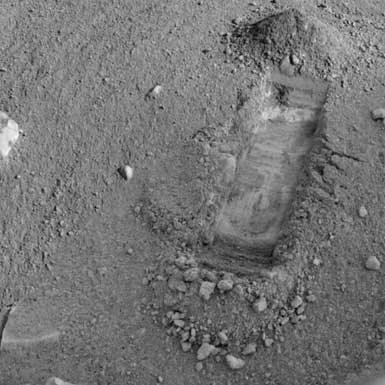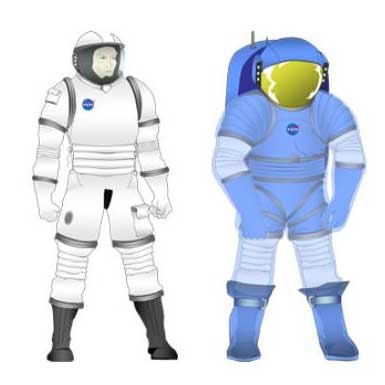 Phoenix has continued to dig on the surface of Mars in search of the oh-so-elusive water ice, with some new trenches and new glitches. NASA is hard at work designing the next generation of space suits that will take our astonauts to the moon and beyond. New nanotube technology looks promising in defeating cancerous cells. Also, TrekMovie celebrates the Summer Solstice with you! All this plus our gadget of the week: the futuristic Kohler Crevasse sink.
Phoenix has continued to dig on the surface of Mars in search of the oh-so-elusive water ice, with some new trenches and new glitches. NASA is hard at work designing the next generation of space suits that will take our astonauts to the moon and beyond. New nanotube technology looks promising in defeating cancerous cells. Also, TrekMovie celebrates the Summer Solstice with you! All this plus our gadget of the week: the futuristic Kohler Crevasse sink.
Phoenix Update: Digging “Snow White” and Loosing Data
Phoenix generated a high volume of data last Tuesday causing the loss of some non-critical science data. Engineers noticed Phoenix’s strange behavior when it sent a piece of engineering data 45,000 times like a broken record. “It’s unfortunate to lose any bit of science,” said mission scientist Ray Arvidson. “But it’s not really critical stuff that you kick yourself over.” The glitch occurred after Phoenix began digging in an area called “Wonderland” early Tuesday, taking its first scoop of soil from a polygonal surface feature likely caused by the shrinking and expansion of water ice. This area has been dubbed the “national park” region of Mars that mission scientists have been preserving for science. Pictured below is the newest trench known as Snow White.

The “Snow White” trench dug by Phoenix Tuesday
UPDATE: NASA Confirms Ice
Today NASA announced that Phoenix has found proof of water ice on Mars. More at Space.com and NASA.gov
Next Generation of NASA Spacesuits
NASA has just awarded its contract for future spacesuits to Oceaneering International, a company that now has the task of designing and manufacturing the new suits to be worn by our future astronauts as they explore the moon, Mars, and beyond. The suits are going to be ready for the first launch of the Orion Space Capsule in 2015, and it’s going to set back the government a whopping $745 million.

The two new space suit designs by Oceaneering International
Infrared-heated nanotubes seek out cancer cells, torch them
The war on cancer has a new secret weapon: carbon nanotubes heated up via near-infrared light, scorching the cancerous cells inside the body. Developed by scientists at the University of Texas Southwestern Medical Center, the nanotubes are stronger than steel and can be attached to an antibody that seeks out cancer cells and bind to them. At that point, the near-infrared light is beamed in, heating the tubes up until the cancer is roasted.

Nanotubes: a better way to fight cancer?
10 Things You Didn’t Know About the Summer Solstice
Today, June 20th, marks the 2008 Summer solstice (or Winter solstice for those of you South of Earth’s equator). This is the first time since 1896 – 112 years – that the summer solstice in the Northern Hemisphere has occurred before June 21. To kick off the official summer season, we at TrekMovie have provided a list of 10 facts surrounding the Summer Solstice.
- Summers are hot not because Earth is closer to the sun, but because the tilt of the Earth’s axis lets rays of sunlight hit one hemisphere more directly.
- During the Northern Hemisphere’s summer, we’re actually farthest from the sun, receiving 7 percent less sunlight than the Southern Hemisphere does during its summer.
- The summer solstice—June 20 this year—is the Northern Hemisphere’s longest day, with 24 hours of unbroken sunlight north of the Arctic Circle.
- For obsessive-compulsives: The site www.archaeoastronomy.com maintains a second-by-second countdown to each solstice.
- The Tropic of Cancer—the latitude on Earth where the sun is directly overhead at noon on the summer solstice—got its name because when the ancients established it, the sun appeared in the constellation Cancer. But, due to subsequent shifting of Earth’s axis, the Tropic of Cancer is now misnamed. On the current June solstice, the sun actually appears in the constellation Taurus.
- Other planets have solstices too. By cosmic coincidence, this year Mars and Earth have solstices that fall within a few days of each other, with the Martian solstice occurring on June 25.
- Uranus’s axis of rotation is nearly aligned with the plane of its orbit, meaning that each pole on Uranus experiences a 42-year-long summer of steady sunshine—followed by a depressing 42 years of winter darkness.
- At the other extreme, Venus’s and Jupiter’s poles are almost exactly perpendicular to their orbits. Because of that, their solstices—hence their seasons—are barely noticeable. Then again, you would have difficulty noticing any kind of season on Venus because you would be simultaneously suffocated, crushed, and cooked at 870 degrees Fahrenheit. On Jupiter it would be worse: You would be killed by radiation long before you got close.
- Even without seasons, changes in the sun affect the planets. Sunspots wax and wane on an 11-year cycle; at times of peak sunspot activity, such as the year 2000, the sun is 0.07 percent brighter than during periods of low activity.
- And the sun keeps getting brighter. Models of stellar evolution estimate that the sun is about 40 percent more luminous today than it was when the Earth formed 4.5 billion years ago.
Video of the week: counting monkeys
Forget about being smarter than a third grader, are you smarter than a chimp? Check out this video and prepare to be worried about our future simian overlords.
Gadget of the Week: Kohler Crevasse prep sink belongs on the Enterprise
The Kohler Crevasse rinsing sink looks like a 33-inch stainless steel slot cut out of your countertop. A button press whisks food scraps down the drain, and you can choose to automatically activate a synchronized garbage disposer at the same time. Check out that swank stainless steel switch with its edge-lit indicator, lighting up in a blue glow when the flume of water rinses the sink, and then flashing blue when the grinder is whirring away. It’s all safe, too, because the switch can only be activated by a human touch, not by some errant pot or pan. Via DVICE.

Sleek futuristic sink belongs in futuristic kitchens
Science Quickies
Here’s a warp-speed look at science tid-bits that didn’t quite make the cut, but nonetheless merit mention.
- NASA Tests Lunar Bots and Suits
- Scientists find trio of “super Earths”
- New type of comet dust mineral discovered
- “Titan Unveiled” a look at the accomplishments of Cassini-Huygens
- Plutoid fallout: New Horizons principal investigator applies the “Starship Enterprise test” for his definition of a planet

That spacesuit on the left is looking pretty close to a Trek pressure suit, no?
No,, more like a Stormtrooper I thought
I really dont think that white stuff is ice on Mars,
because that big chunk of Ice, that they took a pic of under the Phoenix lander last week, should of melted or of showed signs of melting,from the rockets by landing.
( Just a thought )
:o )
what happened to planet X?
sorry but that sink just dosnt ring my bell
i like that ‘cheese on pizza sauce’ bit. that was funny
the ent test kinda sounds like judguing a book by its cover to me. i would just have prefered that the iau wait till a probe was sent to pluto beforee making any announcments. for all we know theyll give us moree again when our probe does ge tthere. and that bothers me that they would end up having toi change their mind so often.
Whoo Hoo!! Mars!
Let’s go! Suit me up!
I love skience.
I wish it could be in my lifetime when the first space explorers find life outside of our solar system, if ever that happens.
2.
I saw an article today reporting that the “white stuff” did indeed melt and is therefore ice. I am not sure where I saw the article but I am also waiting for the news to be picked up by the major news organizations. Maybe it already has — I’ve got the TV turned off today.
Duane
Why do they still keep on developing these ridiculous, ugly and bulky pressurized suits when Astronauts could already wear slick mechanical counterpressure suits? They are cheaper, lighter, do not need any heating or cooling, the look better (in my opinion) and Astronauts can actually MOVE wearing them!
I mean… c’mon, this technology has been studied back in the 1960ies and they got extremely promising results, a few years ago the MIT was to design such suits called “Bio Suit” for Moon and Mars exploration…
Where has all of this gone? Poof?
the chimp story is…fascinating.
Fascinating? No, but it is… interesting.
Meanwhile, $745 million for a design? Frankly, we should be sending probes and rovers, and launching space-borne scopes. Human exploration is best left for science fiction.
However, the ideal Mars astronaut program would take volunteers who would remain on Mars, and not be returned to Earth….
#7
Can you cite any references for what you are stating? I would be interested in reading more about that.
Thanks.
#7
Actually never mind, I found some bits already… :-)
This came from the Science Quickie bullet “Plutoid fallout: New Horizons principal investigator applies the “Starship Enterprise test” for his definition of a planet”:
“So people are asking, “What do we need these guys for? We’ll set up an alternative.” The IAU has no special claim. They have no police force or army. They’re not the Supreme Court. If they’re doing a bad job …”
I love it…..rebel scientists ready to revolt against authority. I reach you brother! Chant after me: Pluto is a planet, dammit!
Those monkeys are smarter than the IAU members.
You mean we’re not gonna wear pastel polyester leisure suits to Mars??
Love the chimps. But, the one in the graphic behind Charlie’s head looks less like Rodan’s Thinker than it does like a chimp on a commode.
Also, I thought for sure you’d have the kissing robot:
http://www.nydailynews.com/news/us_world/2008/06/17/2008-06-17_dont_cha_wish_your_girlfriend_were_batte.html
Thanks, Kayla. By the way — I don’t need batteries. Just in case you wanted to know…
I be puttin’ on me blue suit, and steppin’ out ta’ tha’ long day o’ sunlight ta’ go diggin’ in tha’ sand…and whut do I sees?
Monkeys counting tha’ stuff they be flingin’ at me… and boy, can they count high…
Lucky I got me fancy new sink to wash me blue suit in…
arrrrrrr….
Great article Kayla although I’m a little bummed out that I’m not smarter than a chimp.
I hate to break it to you, but there was only one thing in the solstice list that I didn’t know. Namely that Mars was also close to its solstice.
Will, we hereby award you the Nerdleaf cluster with gold (and broken and fixed with tape) hornrim glasses attachment.
I suppose that a suit for exploring Ceres would be something about halfway between the Mars Suit, and the Moon Suit.
Wondering (NOT hoping) how long it will be before they use Nanotube Implants for erectile dysfunction.
#18 A suit for Ceres would need to be like the Lunar suit… essentially no atmosphere at all to work with. At least Mars has a bit of something… not much, but something. (Now, if only Ahhhnold could just find the frozen atmosphere machines!)
Good article. The counterpressure suit mentioned in #7 kind of resembles the original TMP suit. (space.com).
On the suit:
The patch is on the wrong side. Sheesh. lol jk
From http://www.drudgereport.com
NASA: THERE’S ICE OUT THERE!
I love tidbits like the 10 Things You Didn’t Know About Summer Solstice!
Happy Summer Solstice everyone!! :-)
These suits, in my opinion, look like something you would find on a deep sea mission, not on a deep space mission. I don’t see how they would be comfortable for the wearer. And as for the price tag? I would like to see how they arrived at that figure.
Well, I did research on this company – Oceaneering International. They have been in business with major corporations and government agencies since 1964. They have built suits for diving, which would partially explain the appearance of these suits. (IOW, they are a major contractor for our government. This explains their initial cost assessment for the suits. Would anyone be surprised if the cost increases, and if there are significant additions or subtractions to the suits before the first prototype?)
2, 6 RE: Martian ice
The ice on Mars that the Phoenix is seeing isn’t “melting”, it’s actually vaporizing once its exposed to the sun. Going from a solid state to a gaseous state without ever becoming liquid. Yikes.
27, It’s called “Subduction.”
#’s 27 / 28, Correcting myself. The process is called SUBLIMATION.
( ie: a solid passing through phase directly into a gas, bypassing the liquid state).
Sublimation happens on earth all the time, especially on a sunny winter day below freezing.
I realize i am risking sounding really stupid here but How do they know that the white they saw was not something powdery that just blew away? My understanding was when they announced “ITS ICE !” they had not even taken any samples yet or run any tests….. At least that is what they said on television here when it was announced that they were planning on taking their first samples over the next few days and running them through the lab. I don’t understand how one could really tell the difference between ice evaporating and a light powder blowing away without solid testing….. I think they should have done the tests first imho
Do they have Fluff on Mars?
Hey Nano-tubes COOL !!!!
This is the closest I will ever get to 7 of 9 I guess…..SIGN ME UP !!!!
I’m just checking back ta’ make sure it’s still summer…
re: sublimation- like passin’ gas… that chili turned form solid ta’ gas straight away in me bowels…?
Arrrr